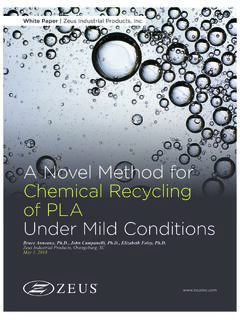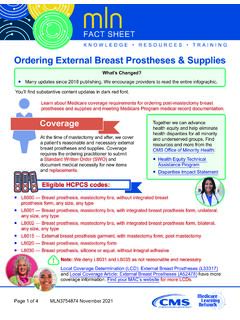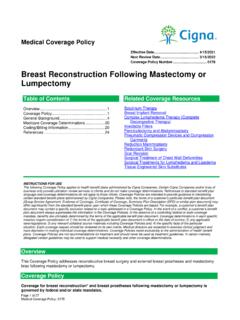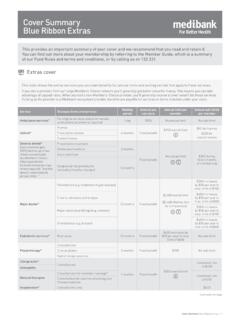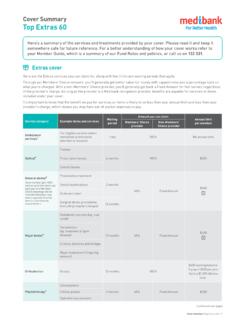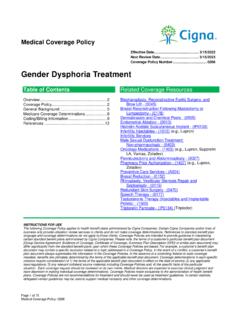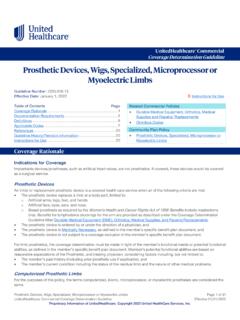Transcription of BIOCOMPATIBILITY OF PLASTICS - zeusinc.com
1 BIOCOMPATIBILITY OF PLASTICS REVISED AND EDITED BY KEVIN J. BIGHAM, PhD. SPECIAL EDITION RESINATE Your quarterly newsletter to keep you informed about trusted products, smart solutions, and valuable updates. 2010; 2017 Revised and edited by Kevin J. Bigham, PhD. 2010 and 2017 Zeus Industrial Products, Inc. 2 2 BIOCOMPATIBILITY OF PLASTICS INTRODUCTION PLASTICS have many unique properties regarding their manufacturability and production potential. These properties are increasingly being utilized in the production of medical devices and medical packaging. The medical device industry is one of the fastest growing areas for PLASTICS with growth rates exceeding gross domestic product growth for several years. This trend is predicted to continue into the future due to developments of increasingly innovative medical devices, improvements in PLASTICS technology (both materials and processing), and an aging population.
2 Despite this significant growth, one thing remains constant: The application of any material in a medical device must meet stringent safety requirements. BIOCOMPATIBILITY BIOCOMPATIBILITY is a general term used to describe the suitability of a material for exposure to the body or bodily fluids with an acceptable host response. BIOCOMPATIBILITY is dependent on the specific application and circumstance of the material in question: A material may be biocompatible in one particular usage but may not be in another. In general, a material may be considered biocompatible if it causes no harm to the host. This is distinct, however, from causing no side effects or other consequences. Frequently, material that is considered biocompatible once implanted in the body will result in varying degrees of inflammatory and immune responses.
3 For a biocompatible material, these responses are not harmful and are part of body s normal responses. Materials that are not biocompatible are those that do result in adverse (harmful) effects to the host. Non-biocompatible materials can disrupt normal healing processes and can have protracted and broad consequences. Indications that a material is not biocompatible include: Chronic inflammation at the area of contact Production of cytotoxic substances Cell disruption Skin irritation Restenosis (narrowing of blood vessels after stenting) Formation of blood clots (thrombosis) Corrosion of implanted material Thus, BIOCOMPATIBILITY is a fundamental hurdle that any potential implantable device or component must overcome. Revised and edited by Kevin J.
4 Bigham, PhD. 2010 and 2017 Zeus Industrial Products, Inc. 3 3 BIOCOMPATIBILITY OF PLASTICS TESTING AND ASSESSMENT Testing and evaluation for BIOCOMPATIBILITY vary widely based on the intended application of the device or component. One set of tests for a particular material may not be required for the material in a different application. Testing regimes are broad in scope and encompass in vivo and in vitro evaluations. BIOCOMPATIBILITY test protocols include those for cytotoxicity, hemocompatibility, genotoxicity, irritation, implantation, sensitization, and system toxicity. Additionally, BIOCOMPATIBILITY protocols must account for potential misuse of the device or component. ISO 10993: BIOLOGICAL EVALUATION OF MEDICAL DEVICES The International Organization for Standardization (ISO) presents widely adopted medical device guidelines that are aimed with a keen focus towards risk management.
5 BIOCOMPATIBILITY testing for these devices and device components is addressed by ISO standard 10993. (There are other country-specific guidelines that largely overlap with ISO 10993, however, but those programs shall not be discussed here). This set of documents entitled, Biological evaluation of medical devices, is issued currently in twenty parts and is regularly revised to reflect new findings (Table 1). Early consideration in BIOCOMPATIBILITY testing is given to material characterization. If the material in question has a proven acceptably safe history of medical use, very often this phase of evaluation can be omitted. For new materials or new applications for previously used materials, ISO 10993 provides guidance on methodology and appropriate test program.
6 Revised and edited by Kevin J. Bigham, PhD. 2010 and 2017 Zeus Industrial Products, Inc. 4 4 BIOCOMPATIBILITY OF PLASTICS Table 1: Structure and parts of ISO 10993: Biological evaluation of medical devices Part Title 1 Evaluation and testing 2 Animal welfare requirements 3 Tests for genotoxicity, carcinogeniticity and reproductive toxicity 4 Selection of tests for interaction with blood 5 Tests for cytotoxicity - in vitro methods 6 Tests for local effects after implantation 7 Ethylene oxide sterilization residuals 8 Clinical investigation of medical devices 9 Degradation of materials related to biological testing 10 Test for irritation and sensitization 11 Test for systemic toxicity 12 Sample preparation and reference materials 13 Identification and qualification of degradation products from polymers 14 Identification and qualification of degradation products from ceramics 15 Identification and qualification of degradation products from coated and uncoated metals and alloys 16 Toxicokinetic study design for degradation products 17 Glutaraldehyde and
7 Formaldehyde residues in industrially sterilized medical devices 18 Chemical characterization of materials 19 Physico-chemical, morphological and topographical characterization of materials 20 Principles and methods for immunotoxicology testing of medical devices The selected test program depends on several factors based on the device category determined by ISO 10993. The material used, contact regime, and time duration of contact with the device help determine the test program (Table 2). Contact time is broken into three periods: short duration (< 24 hours), prolonged contact (24 hours to 30 days), and permanent contact (> 30 days). Contact regime describes how the device will come in contact with the body such as via blood, skin, bone, etc.
8 These elements help provide a foundation for biological evaluation of medical devices. ISO 10993 is not a formal checklist but a guide to the typical information requirements for approval authorities. ISO 10993 is intended to assist manufacturers and engineers in designing an appropriate testing program for their device. Testing details are thus specific to each device and its application though there may be testing commonalities for multiple device types. Revised and edited by Kevin J. Bigham, PhD. 2010 and 2017 Zeus Industrial Products, Inc. 5 5 BIOCOMPATIBILITY OF PLASTICS Table 2: Device categories and biological evaluation of medical devices for ISO (from ISO 10993: Part 1). Device category Contact regime Contact Timescale Example products Surface devices Skin Limited Electrodes, external prostheses , fixation tapes, compression bandages, monitors of various types Prolonged Permanent Mucous membrane Limited Contact lenses, urinary catheters, intravaginal and intraintestinal devices (stomach tubes, sigmoidoscopes, colonoscopes, gastroscopes)
9 , endotracheal tubes, bronchoscopes, dental prostheses , orthodontic devices, IUDs Prolonged Permanent Breached or compromised surfaces Limited Ulcer, burn and granulation tissue dressings or healing devices, occlusive patches Prolonged Permanent Externally communi-cating devices Blood path indirect Limited Solution administration sets, extension sets, transfer sets, blood administration sets Prolonged Permanent Tissue / bone / dentin communicating Limited Laparoscopes, arthroscopes, draining systems, dental cements, dental filling materials, skin staples Prolonged Permanent Circulating blood Limited Intravascular catheters, temporary pacemaker electrodes, oxygenators, extracorporeal oxygenator tubing and accessories, dialyzers, dialysis tubing and accessories, hemoadsorbents and immunoadsorbents Prolonged Permanent Implant devices Tissue / bone implant devices Limited Orthopedic pins, plates, replacement joints, bone prostheses , cements and intraosseous devices, pacemakers, drug supply devices, neuromuscular sensors and simulators, replacement tendons, breast implants, artificial larynxes, subperiosteal implants, ligation clips Prolonged Permanent Blood Limited Pacemaker electrodes, artificial arteriovenous fistulae, heart valves, vascular grafts, internal drug delivery catheters, ventricular assist devices Prolonged Permanent Time Span Key: Limited: < 24 hours Prolonged: 24 hrs - 30 d Permanent: > 30 days Revised and edited by Kevin J.
10 Bigham, PhD. 2010 and 2017 Zeus Industrial Products, Inc. 6 6 BIOCOMPATIBILITY OF PLASTICS OTHER REGULATIONS In conjunction with ISO 10993, in the United States the Food and Drug Administration (FDA) regulates medical devices. FDA guidelines largely agree with ISO 10993 regulations. (ISO test results are generally acceptable for applications in the United States). European Union device manufacturers under the authority of the European Commission are governed by Regulations (EU) 2017/745-6 for general medical devices and in vitro diagnostic medical devices. Collectively, these organizations address nearly all conceivable medical device testing concerns. Readers are encouraged to refer to individual parts of ISO 10993, the FDA, or EU Medical Device Directives for further information on specific testing.
